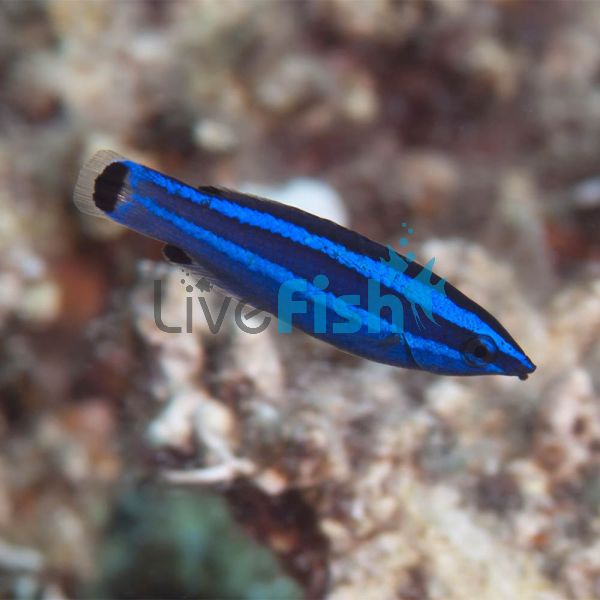Red Sea Four Line Wrasse - Medium
The Red Sea Four Lined Wrasse, as the name suggests, has 4 lines running down the length of its back. It’s not until you notice the piercing arctic blue against the dark blue canvas of its body, that you understand why this is such a sought after fish. It’s certainly an eye-catcher.
The Four Line Cleaner Wrasse has an exquisite deep blue body with four horizontal lighter blue stripes running from head to tail. It can also have a little hint of purple in its tail trim.
Cleaner Wrasses are well known for setting up "cleaning stations". These are usually at a cave entrance or overhang, where it swims in a bobbing, dance-like motion. Red Sea Cleaner Wrasses are no different. They’ll welcome larger fish to their cleaning station to remove and eat parasites from their scales. You’ll often see them entering the mouths and gills of Groupers and other large reef fish.
Its eating habits change as they grow. As a juvenile, the Red Sea Four Line Wrasse is a cleaner. Then as they migrate to adulthood, they tend to favour coral polyps and that can pose a problem for hobbyists. Only the most experienced aquarist should keep these fish. They are very high maintenance.
They originate from the Western Indian Ocean around the Red Sea and the Gulf of Aden.
Tank Recommendations for Red Sea Four Lined Wrasse
The smallest tank size for these wrasses is 115 Litres. However, when you take into account their feeding habits (eating parasites from larger fish) it’s more likely you’ll need to host them in a larger tank.
An aquarium with plenty of live rock with an abundance of cracks and crevices is a must as they like to hide. A substrate of about 7cm is also recommended due to their sleeping habits. (They like to bury themselves at night).
A lid is essential as Wrasse tend to jump from the tank when they get startled.
Care should be taken when introducing this Wrasse to a live reef setup as adults are very fond of coral polyps.
Suitable Tank Buddies
Red Sea Four Lined Wrasse are relatively peaceful so they’ll mix well in most scenarios. That said, their change in eating habits that comes with age can present compatibility issues.
Usually Compatible
Angelfish, Goatfish, and Blennies make good tank mates, as do Tangs and Damselfish
Sometime Compatible
The Red Sea Four Line Wrasse can become aggressive towards other less aggressive Wrasses, so mixing Wrasses needs a cautious approach. You should also be monitor them if mixing them with Groupers, Hawkfish, and Parrotfish.
Rarely Compatible
Pufferfish and Boxfish are two species that should be avoided at all costs. Because these fish can get anxious easily and your Red Sea Wrasse will harass them. Scorpionfish, Lizardfish, and Frogfish are likewise to be avoided because they are known to consume them. Avoid other Red Sea Four Line Wrasses, you should only have one in your tank. Adults shouldn’t be introduced to a live coral environment.
Feeding Your Red Sea Four Line Wrasse
They are carnivores so, their diet can include brine shrimp, mysis shrimp, finely diced marine seafood. A frozen carnivore mix is also a good option, among other meaty offerings. If housed with larger fish they will feed on any parasites on them and dead scales too.
| Scientific Name | Larabicus quadrilineatus |
|---|---|
| Care Level | Hard |
| Common Names | Red Sea Cleaner Wrasse, Red Sea Four Line Wrasse |
| Diet | Carnivore |
| Fish Family | Labridae |
| Lifespan (years) | 5 |
| Max. Length (cm) | 12 |
| Min. Tank Volume (l) | 115 |
| Origin | West Indian Ocean, Red Sea |
| Reef Safe | No |
| Sociability | Semi-aggressive |
| Venomous | No |
| Water Conditions | 22.2-25.5° C (72-78° F), dKH 8-12, pH 8.1-8.4, sg 1.020-1.025 |




